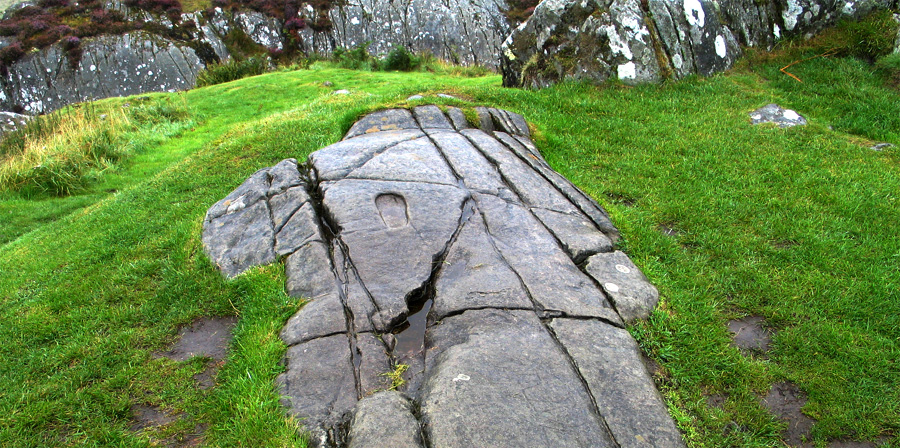 From about 500 to 900 A.D., Dunadd was the capital of the Kingdom of Dal Riata, established across Argyll by the "original" Scots, migrants from Ireland.At one time an island, it now lies inland near the River Add. The surrounding land, now largely reclaimed, was formerly boggy and known as the Mòine Mhòr ('Great Moss' in Gaelic).
From Dunadd, the Scots eventually incorporated the lands of the Picts. Kenneth MacAlpin, King of the Scots of Dalriada, also become King of the Picts in 843 A.D. By 850 A.D., because of Viking raids, the seat of power was moved from Dunadd to Scone, near Perth.
Dunadd Fort is known for unique stone carvings near the top of the hill it is on, including a footprint and basin thought to have formed part of Dál Riata's coronation ritual. Also on the same flat outcrop of rock is an incised boar in Pictish style and in inscription in the ogham script.
About Dunadd From about 500 to 900 A.D., Dunadd was the capital of the Kingdom of Dal Riata, established across Argyll by the "original" Scots, migrants from Ireland.At one time an island, it now lies inland near the River Add. The surrounding land, now largely reclaimed, was formerly boggy and known as the Mòine Mhòr ('Great Moss' in Gaelic).
From Dunadd, the Scots eventually incorporated the lands of the Picts. Kenneth MacAlpin, King of the Scots of Dalriada, also become King of the Picts in 843 A.D. By 850 A.D., because of Viking raids, the seat of power was moved from Dunadd to Scone, near Perth.
Dunadd Fort is known for unique stone carvings near the top of the hill it is on, including a footprint and basin thought to have formed part of Dál Riata's coronation ritual. Also on the same flat outcrop of rock is an incised boar in Pictish style and in inscription in the ogham script.
About Dunadd
Megalithic Portal: Dunadd
Undiscovered Scotland: Dunadd
Ancient Scotland: Dunadd
Wikipedia: Dunadd
Wikipedia: Hillfort
Wikipedia: Scotti
Undiscovered Scotland: Dalriada
Journey to Dunadd
Dunadd Fort is located off the A816 two miles south of the village of Kilmartin in Argyll and Bute, Scotland.
Ordnance Survey Map (NR8367693573)
Visitors Information
Visitors information may be found at the Historic Scotland website and Kilmartin House Museum website. General tourist information for the mid-Argyll area may be found on the Argyll & The Isles website.
Additional Photos of Dunadd
Sign for Dunadd Fort
Descriptive Sign at Dunadd Fort
Ascending the Hill
Ascending the Hill (with the River Add on the left and the Mòine Mhòr on the right in the Background)
Outcrop with Footprint
Close-Up of Footprint
Rock Cup Bowl
Incised Boar Barely Visible
View from the Summit of Dunadd Fort
|


 From about 500 to 900 A.D., Dunadd was the capital of the Kingdom of Dal Riata, established across Argyll by the "original" Scots, migrants from Ireland.At one time an island, it now lies inland near the River Add. The surrounding land, now largely reclaimed, was formerly boggy and known as the Mòine Mhòr ('Great Moss' in Gaelic).
From Dunadd, the Scots eventually incorporated the lands of the Picts. Kenneth MacAlpin, King of the Scots of Dalriada, also become King of the Picts in 843 A.D. By 850 A.D., because of Viking raids, the seat of power was moved from Dunadd to Scone, near Perth.
Dunadd Fort is known for unique stone carvings near the top of the hill it is on, including a footprint and basin thought to have formed part of Dál Riata's coronation ritual. Also on the same flat outcrop of rock is an incised boar in Pictish style and in inscription in the ogham script.
About Dunadd
From about 500 to 900 A.D., Dunadd was the capital of the Kingdom of Dal Riata, established across Argyll by the "original" Scots, migrants from Ireland.At one time an island, it now lies inland near the River Add. The surrounding land, now largely reclaimed, was formerly boggy and known as the Mòine Mhòr ('Great Moss' in Gaelic).
From Dunadd, the Scots eventually incorporated the lands of the Picts. Kenneth MacAlpin, King of the Scots of Dalriada, also become King of the Picts in 843 A.D. By 850 A.D., because of Viking raids, the seat of power was moved from Dunadd to Scone, near Perth.
Dunadd Fort is known for unique stone carvings near the top of the hill it is on, including a footprint and basin thought to have formed part of Dál Riata's coronation ritual. Also on the same flat outcrop of rock is an incised boar in Pictish style and in inscription in the ogham script.
About Dunadd